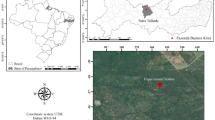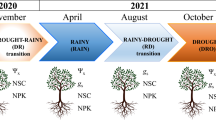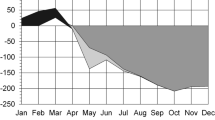Summary
The degree of winter desiccation resistance exhibited by Larix lyallii Parl. was assessed by determination of water potential components and content of buds, xylem pressure potential (Ψ xylem) of twigs and amount of damage through winter at timberline in the Rocky Mountains of Canada. Comparative measurements were made on sympatric evergreen tree species to evaluate differences in winter desiccation avoidance and tolerance between evergreen and deciduous trees. Total (Ψ) and osmotic plus matric potentials (Ψ π + τ) of L. lyallii buds were lowest in December (-5.0 to-5.3 MPa and-6.6 to-7.0 MPa, respectively) when temperatures were lowest. Bud Ψ and water content increased in late winter while Ψ xylem of twigs continued to decline until March. The buds were isolated from the xylem from October through February, as indicated by large differences in water potential between the two organs during this time. Buds thus avoided desiccation as water was lost from the twigs. At the same time the buds were tolerant of very low Ψ and Ψ π + τ, a characteristic which is an important component of freezing damage resistance. Desiccation damage to buds of L. lyallii was much less than that to buds of similar-sized nearby trees of Abies lasiocarpa, although Ψ xylem of both species was similar. The deciduous habit apparently confers a significant advantate to L. lyallii, which dominated the upper timberline sites, in reduced susceptibility to winter desiccation damage. Other deciduous timberline species might also benefit from this advantage where winter conditions are desiccating.
Seedlings of L. lyallii were also studded for their winter desiccation resistance because they have a large component of non-deciduous (wintergreen) needles that are photosynthetically active through two growing seasons and must overwinter as mature tissue. Experimental exposure of these needles, which are normally protected by the snowpack, caused nearly complete mortality of the wintergreen needles when twig Ψ xylem was only-3.9 MPa. The buds on these twigs were undamaged.
Similar content being viewed by others
References
Arno SF, Habeck JR (1972) Ecology of alpine larch (Larix lyallii Parl.) in the Pacific Northwest. Ecol Monogr 42:417–450
Baig MN, Tranquillini W (1976) Studies on upper timberline: morphology and anatomy of Norway spruce (Picea abies) and stone pine (Pinus cembra) needles from various habitat conditions. Can J Bot 54:1622–1632
Baig MN, Tranquillini W, Havranek WM (1974) Cuticuläre Transpiration von Picea abies- und Pinus cembra-Zweigen aus verschiedener Seehöhe und ihre Bedeutung für die winterliche Austrocknung der Bäume an der alpinen Waldgrenze. Cbl Ges Forstw 91:195–211
Beck E, Schulze E-D, Senser M, Scheibe R (1984) Equilibrium freezing of leaf water and extracellular ice formation in Afroalpine ‘giant rosette’ plants. Planta 162:276–282
Daubenmire R (1945) An improved type of precision dendrometer. Ecology 26:97–98
Environment Canada (1968–1978) Compilation of the hydrometeorological record, Marmot Creek Basin, Vol. 4–14, Calgary Dist, Water Survey Canada, Dept Env, Calgary, Alberta, Canada
Goldsmith GW, Smith JH (1926) Some physicochemical properties of spruce sap and their seasonal and altitudinal variation. Colo College Publ Sci Ser 13:13–71
Hadley JL, Smith WK (1983) Influence of wind exposure on needle desiccation and mortality for timberline conifers in Wyoming, U.S.A. Arct Alp Res 15:127–135
Hämet-Ahti L, Ahti T (1969) The homologies of the Fennoscandian mountain and coastal birch forests in Eurasia and North America. Vegetatio 19:208–219
Hansen DH, Klikoff LG (1972) Water stress in krummholz, Wasatch Mountains, Utah. Bot Gaz 133:392–394
Holtmeier FK (1971) Waldgrenzenstudien im nördlichen Finnisch-Lappland und angrenzenden Nordnorwegen. Rep Kevo Subarctic Res Stat 8:53–62
Jansson E, Jensén P, Bornmann CH (1983) Effect of the crown on uptake and transport in embryonic shoots of Picea abies. Physiol Plant 59:521–527
Jarvis PG (1975) Water transfer in plants. In: de Vries DA, Afgan NH (eds) Heat and mass transfer in the environment of vegetation. 1974 Seminar of the International Centre for Heat and Mass Transfer, Dubrovnik. Scripta, Washington, DC, pp 369–394
Larcher W (1957) Frosttrocknis an der Waldgrenze und in der alpinen Zwergstranchheide auf dem Patscherkofel bei Innsbruck. Veroff Ferdinandeum Innsbruck 37:49–81
Larcher W (1963) Zur spätwinterlichen Erschwerung der Wasserbilanz von Holzpflanzen an der Waldgrenze. Ber Naturwiss Med Ver Innsbruck 53:125–137
Larcher W (1972) Der Wasserhaushalt immergrüner Pflanzen im Winter. Ber Deutsch Bot Ges 85:315–327
Larcher W (1985) Winter stress in high mountains. In: Turner H, Tranquillini W (eds) Establishment and Tending of Subalpine Forest: Research and Management. Proc 3rd IUFRO Workshop P 1.07-00, 1984, Eidg Anst forstl Versuchswes, Ber 270:11–19
Lewis FJ, Dowding ES (1924) The anatomy of the buds of Coniferae. Ann Bot 38:217–228
Lindsay JH (1971) Annual cycle of the leaf water potential in Picea engelmannii and Abies lasiocarpa at timberline in Wyoming. Arct Alp Res 3:131–138
Marchand PJ, Chabot BF (1978) Winter water relations of tree-line plant species on Mt. Washington, New Hampshire. Arct Alp Res 10:105–116
Mayo JM (1974) A thermocouple psychrometer chamber for field and laboratory use. Can J Plant Sci 54:597–598
Michaelis P (1934a) Ökologische Studien an der alpinen Baumgrenze. IV. Zur Kenntnis des winterlichen Wasserhaushaltes. Jahrb Wiss Bot 80:169–298
Michaelis P (1934b) Ökologische Studien an der alpinen Baumgrenze V. Osmotischer Wert und Wassergehalt während des Winters in den verschiedenen Höhenlagen. Jahrb Wiss Bot 80:337–362
Millar BD, Hansen GK (1975) Exclusion errors in pressure chamber estimates of leaf water potential. Ann Bot 39:915–920
Müller-Stoll WR (1954) Beiträge zur Ökologie der Waldgrenze am Feldberg im Schwarzwald. In: Janchen E (ed) Angewandte Pflanzensoziologie, Festschrift Erwin Aichinger, vol 2. Springer, Wien, Austria, pp 824–827
Nobel PS (1974) Introduction to biophysical plant physiology. Preeman, San Francisco, California
Owens JH, Molder M (1979) Bud development in Larix occidentalis. I. Growth and development of vegetative long shoot and vegetative short shoot buds. Can J Bot 57:687–700
Pisek A, Larcher W (1954) Zusammenhang zwischen Austrocknungsresistenz und Frosthärte bei Immergrünen. Protoplasma 44:30–46
Pisek A, Winkler E (1958) Licht-und Temperaturabhängigkeit der CO2-Assimilation von Fichte (Picea excelsa Link), Zirbe (Pinus cembra L.), und Sonnenblume (Helianthus annus L.). Planta 53:532–550
Platter W (1976) Wasserhaushalt, cuticuläres Transpirationsvermögen und Dicke der Cutinschichten einiger Nadelholzarten in verschiedenen Höhenlagen und nach experimenteller Verkürzung der Vegetationsperiode. PhD Dissertation, Univ Innsbruck, Austria
Quintanilla V (1977) A contribution to the phytogeographical study of temperate Chile. In: Muller P (ed) Ecosystem research in South America. Biogeographica Vol VIII. Junk, The Hague, Netherlands, pp 31–41
Richards JH (1981) Ecophysiology of a deciduous timberline tree, Larix lyallii Parl. PhD Dissertation, Univ Alberta, Edmonton, Alberta, Canada
Richards JH (1985) Ecophysiological characteristics of seedling and sapling subalpine larch, Larix lyallii, in the winter environment. In: Turner H, Tranquillini W (eds) Establishment and Tending of Subalpine Forest: Research and Management. Proc 3rd IUFRO Workshop P 1.07-00, 1984, Edig Anst forstl Versuchswes. Ber 270:103–112
Romberger JA (1963) Meristems, growth and development in woody plants. USDA, For Serv Tech Bull No 1293, Washington, DC
Sakai A (1979) Freezing avoidance mechanism of primordial shoots of conifer buds. Plant Cell Physiol 20:1381–1390
Sakai A (1982) Freezing tolerance of shoot and flower primordia of coniferous buds by extraorgan freezing. Plant Cell Physiol 23:1219–1227
Sokal RR, Rohlf FJ (1969) Biometry. Freeman, San Francisco, California
Spanner DC (1951) The Peltier effect and its use in the measurement of suction pressure. J Exp Bot 2:145–168
Steiner M (1935) Winterliches Bioklima und Wasserhaushalt der Pflanzen an der alpinen Baumgrenze. Bioklim Beibl 2:57–65
Tranquillini W (1957) Standortsklima, Wasserbilanz und CO2-Gaswechsel junger Zirben (Pinus cembra L.) an der alpinen Waldgrenze. Planta 49:612–661
Tranquillini W (1979) Physiological ecology of the alpine timberline. Ecological Studies 31, Springer, Berlin Heidelberg New York
Troll C (1973) The uper timberlines in different climatic zones. Arct Alp Res 5:A3-A18
Wang C-W (1961) The forests of China. Maria Moors Cabot Foundation Publ No 5, Harvard Univ, Cambridge, Massachusetts
Wardle P (1968) Engelmann spruce (Picea engelmannii Engel.) at its upper limits on the Front Range, Colorado. Ecology 49:483–495
Wardle P (1971) An explanation for Alpine timberline. NZ J Bot 9:371–402
Waring RH, Running SW (1976) Water uptake, storage and transpiration by conifers: a physiological model. In: Lange OL, Kappen L, Schulze ED (eds) Water and plant life. Springer, Berlin Heidelberg New York, pp 189–202
Waring RH, Running SW (1978) Sapwood water storage: its contribution to transpiration and effect upon water conductance through the stems of old-growth Douglas-fir. Plant Cell Environ 1:131–140
Wiebe HH, Brown RW, Daniel TW, Campbell E (1970) Water potential measurements in trees. Bioscience 20:225–226
Author information
Authors and Affiliations
Rights and permissions
About this article
Cite this article
Richards, J.H., Bliss, L.C. Winter water relations of a deciduous timberline conifer, Larix lyallii Parl.. Oecologia 69, 16–24 (1986). https://doi.org/10.1007/BF00399032
Received:
Issue Date:
DOI: https://doi.org/10.1007/BF00399032




